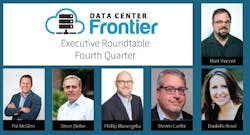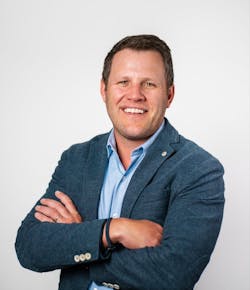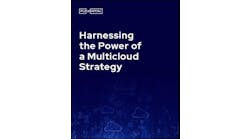Executive Roundtable: Actionable Data Center Sustainability Strategies
At minimum, implementing actionable sustainability programs in the hyperscale and colocation data center industry appears to require a proactive, transparent, and measurable approach, especially in the face of intensifying climate challenges. Also, collaboration across industries and governments seems essential, leveraging collective innovation to push boundaries in such vital areas as grid decarbonization and sustainable materials for construction, to name just two.
Beyond operational changes, we also know that tenets of actionable sustainability usually involve transparent reporting through frameworks like the Science-Based Targets initiative (SBTi) and adherence to global Environmental, Social, and Governance (ESG) standards, ensuring stakeholders can verify progress.
For the third installment of our Executive Roundtable for the Fourth Quarter of 2024, we polled our panel of distinguished industry experts on the most pivotal sustainability considerations and actions for colocation and hyperscale data centers headed into 2025.
In a recent contributed article to DCF's 'Voices of the Industry' forum, Kevin Brown SVP, EcoStruxure Solutions, Secure Power Division, at Schneider Electric, offered some specific guidance on this topic.
Brown advises:
"Monitoring and maintaining IT infrastructure has become increasing difficult. CIOs were used to keeping it resilient and secure but increasingly, they must keep it sustainable [...] The Wall Street Journal article confirmed what we at Schneider Electric have been focused on as we help CIOs shift their mindset to one that prioritizes sustainability and emphasizes taking action [...] I understand it is not an easy shift to make and CIOs are in the spotlight as they attempt to navigate this new world. But it doesn’t have to be a Herculean task.
For many CIOs, the main problem is they aren’t sure where to start. So, let me recommend one metric to get your sustainability journey underway: Figure out how much energy your IT is consuming. Half of it is coming from outside your data center. Don’t wait for a shareholder or an employee to ask what your company’s IT carbon footprint is. Find out now so you will be able to answer the basic questions - because the next set of questions they ask will require even greater granularity into your sustainability metrics."
Our Executive Roundtable for the Fourth Quarter of 2024 includes the following seasoned data center industry leaders:
- Pat McGinn, Chief Operating Officer, CoolIT Systems
- Steve Zielke, Marketing Manager - Global Channel Distribution & Data Centers, Rehlko
- Phillip Marangella, Chief Marketing and Product Officer, EdgeConneX
- Steven Carlini, Vice President of Innovation and Data Center, Schneider Electric
- Danielle Rossi, Global Director – Mission Critical Cooling, Trane
Now let's look into the third question of the series for our Executive Roundtable for the Fourth Quarter of 2024.
Data Center Frontier: What are the most pivotal sustainability considerations and actions for colocation and hyperscale data centers headed into 2025?
Pat McGinn, CoolIT: Sustainability is no longer a secondary concern—it is a core driver of strategy for colocation and hyperscale data centers heading into 2025. Among the most critical considerations are energy efficiency, water conservation, and resource optimization.
Energy efficiency remains paramount as data centers strive to meet both rising power demands and stringent carbon reduction targets. Water conservation is equally pressing, especially as facilities expand into water-stressed regions where traditional cooling methods face growing scrutiny.
Furthermore, the adoption of circular economy principles, including the repurposing of hardware and waste reduction, will play a growing role in advancing sustainability efforts.
As sustainability pressures intensify, the industry must also focus on systemic approaches—integrating renewable energy, leveraging data for operational efficiency, and engaging in cross-sector collaboration.
These actions are not just about meeting regulations; they are about future-proofing data center operations against environmental and economic risks.
Steve Zielke, Rehlko: One very significant and influential trend that isn't discussed enough is Environmental Product Declarations (EPD). While they are incredibly useful for Scope 3 benchmarking, supply chain management, and even marketing strategy, EPDs simply aren’t common among data centers, their suppliers, or their equipment. Environmental product declarations (EPD) are important for two reasons. First, they offer standardization. EPDs are governed by strict standards and regulations, where product category rules issue comparable results because the calculation methods and reporting guidelines are the same. Through an EPD, a data center gains the assurance of information accuracy, enabling informed, confident choices when selecting a vendor.
The second reason EPDs are so valuable for data centers is the transparency they provide. No EPD can be created without a full lifecycle analysis. As a result, the EPD shows a data center operator what goes into a piece of equipment, how it's produced, and the environmental footprint related to every stage of production.
Phillip Marangella, EdgeConneX: Key sustainability considerations for providers include:
1. Achieving 100% Carbon Free scope 1 and 2 targets to demonstrate commitment to tangible goals and KPI attainment (through green supply, REC/EACS, PPA, and other approved means).
2. Calculating Water Usage Effectiveness (WuE) into the sustainability equation, given its increasing necessity to support the cooling of AI and high-density deployments.
3. Evaluating and leveraging alternative carbon-free energy sources as an augmentative and primary power source.
4. Continue to openly report on sustainability goals and achievements to be transparent as a company and as an industry, and demonstrate a real and concerted commitment to sustainability.
Steven Carlini, Schneider Electric: Sourcing and running on zero carbon sources are a primary goal going forward. As more zero carbon capacity is built, data center operators will be first in line.
Additionally, data center operators will collaborate with grid power providers to cooperate on supply and demand optimization. This means data center operators will strategically use on-site back up power sources – BESS (battery energy storage systems) to charge when being supplied with carbon free power and discharge when the grid is supplying fossil fuel-based power.
Data center operators are at different parts of their sustainability journeys. Those trying to comply with impending regulations are focused on data gathering and reporting. Once they have this, they can put action plans together to reduce carbon output and water use.
Those more advanced on their sustainability journey will focus on the supply chain and their providers to minimize their scope 3 emissions. This is a very large part of emissions for most companies and the most complicated to understand, report and mitigate.
Danielle Rossi, Trane: As we move closer to many companies’ 2030 goals, we are going to see a focus on retrofits and on more holistic planning for greenfield design.
The significant droughts worldwide have forced a reassessment of many brownfield designs. We are seeing an increase in requests for retrofits of water-cooled chillers, in particular. Connecting the chillers to dry coolers, in place of cooling towers, closes the loop and limits the water use to the amount to fill the piping with no continual water usage.
This change significantly helps overall WUE footprint. For greenfield designs, we are noticing this closed-loop design and the request for heat recovery much more frequently. Heat recovery, particularly with high density AI or liquid cooling, can be extremely beneficial to sustainability goals.
Unfortunately, many people limit their planning to district heating which is hard to achieve without extremely high temperatures but there are many options for heat recovery depending on location and water temperature. Holistic planning and site selection are key to optimizing a heat recovery design.

Matt Vincent
A B2B technology journalist and editor with more than two decades of experience, Matt Vincent is Editor in Chief of Data Center Frontier.











